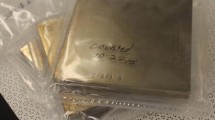Abstract
A brief review of the use of stable lead isotope ratio measurements to identify and apportion sources of lead in human tissue is followed by examples of the use of inductively coupled plasma source mass spectrometry for such studies.
Inductively coupled plasma source mass spectrometry (ICP-MS) has only recently been used for measurements of coupled ratios in body tissues and fluids and in environmental sources of lead. Generally, the inaccuracy of these measurements is about −0.2% and the imprecision less than 0.5%. This analytical performance is sufficient to detect the much larger changes in206Pb:207Pb ratios of −2% or higher, seen in environmental lead exposure and in childhood lead poisoning.
Measurements of lead isotope ratios by ICP-MS have been used to identify specific sources of childhood lead poisoning and to indicate the relative importance of environmental sources, such as drinking water and lead from petrol. Populations in the United Kingdom with low lead uptake usually have206:Pb207Pb ratios in body tissues within the range 1.13 ± 0.01. Significant deviations from this range have been seen in response to increased uptake from lead in: drinking water in parts of Scotland (source ratio ∼1.18 and petrol lead in inner London (source ratio ∼1.07). The dominant source for some Scottish subjects with high concentrations of lead in blood or in teeth was water, which contributed approximately 60% to body lead. Petrol lead was shown to be a significant contributor (30–40%) to the body lead of inner London children.
Similar content being viewed by others
References
Ault, W.U. Senechal, R.G. and Erlebach, W.E. 1970. Isotopic composition as a natural tracer of lead in the environment.Environ. Sci. Technol.,4, 305–313.
Campbell, M.J. and Delves, H.T. 1989. Accurate and precise determination of lead isotopic ratios in clinical and environmental samples using inductively coupled plasma source mass spectrometry.J. Analyt. Atom Spectros.,4, 235–256.
Delves, H.T. 1970. A micro-sampling method for the rapid determination of lead inblood by atomic absorption spectrophotometry.Analyst,95, 431–438.
Delves, H.T. and Campbell, M.J. 1988. Measurement of total lead concentrations and lead isotope ratios in whole blood by use of inductively coupled-plasma source mass spectrometry.J. Analyt. Atom. Spectros.,3, 343–348
Delves, H.T., Clayton, B.E., Carmichael, A., Bubear, M. and Smith, M. 1982. An appraisal of the analytical significance of tooth-lead measurements as possible indeces of environmental exposure of children to lead.Ann. Clin. Biochem.,16, 329–337.
Delves, H.T., Sherlock, J.C. and Quinn, M.J. 1984. Temporal stability of blood lead concentrations in adults exposed only to environmental lead.Human Toxicol.,3, 279–288.
Ewers, U., Brockhaus, A., Winneke, G., Freier, I., Jermann, E. and Kramer, U. 1982. Lead in deciduous teeth of children living in a nonferrous smelter area and in a rural area of West Germany.Int. Archives. Occup. Environ. Health,50, 139–151.
Faccetti, S. and Geiss, F. 1982. Isotopic lead experiment - status report. publ. CEC Luxembourg.
Flegal, A.R., Itoh, K., Patterson, C.C. and Wong, C.S. 1986. Vertical profile of lead isotopic compositions in the north-east Pacific.Nature,321, 689–690.
Fulton, M., Raab, G., Thomson, G., Laxen, D., Hunter, R. and Hepburn, W. 1987. Influence of blood lead on the ability and attainment of children in Edinburgh.The Lancet,i, 1221–1226.
Halls, D.J. 1984. Speeding up determinations by electrothermal atomic absorption spectrometry.Analyst,109, 1081–1084.
Keating, A.D., Keating, L.J., Halls, D.J. and Fell, G.S. 1987. Determination of lead in teeth by atomic absorption spectrometry with electrothermal atomisation.Analyst,112, 1381–1385.
Laxen, D.P.H., Raab, G.M. and Fulton, M. 1987. Childrens blood lead and exposure to lead in household dust and water - a basis for an environmental standard for lead in dust. Sci. Total Environ., 66, 235–244.
Manton, W.I. 1977. Sources of lead in blood.Arch. Environ. Health. July/Aug, 149–159.
Manton, W.I. 1985. Total contribution of airborne lead to blood lead.Brit. J. Ind. Med.,42, 168–172.
Maring, H., Settle, D.M., Buat-Ménard, P., Dulas, F. and Patterson, C.C. 1987. Stable lead isotope tracers of air mass trajectories in the Mediterranean region.Nature,300, 154–157.
MRC (Medical Research Council). 1988.A Review of the Research 1984–1988. Medical Research Council, Advisory Group on Lead and Neuropsychological Effects in Children.
Mullee, M. and Brewster 1. 1987. Bodylead - a programme in Turbo- Pascal to calculate relative contributions of environmental sources to body-lead (personal communication to HTD).
Sherlock, J., Smart, G., Forbes, G.I., Moore, M.R., Patterson, W.J., Richards, W.N. and Wilson, T.S. 1982. Assessment of lead intakes and dose-response for a population in Ayr exposed to a plumbosolvent water supply.Human Toxicol.,1, 115–122.
Sherlock, J.C., Ashby, D., Delves, H.T., Forbes, G.I., Moore, MR., Patterson, W.J., Pocock, S.J., Quinn, M.J., Richards, W.N. and Wilson, T.S. 1984. Reduction in exposure to lead from drinking water and its effects on blood lead concentrations.Human Toxicol.,3, 383–392.
Smith, M., Delves, H.T., Lansdown, R., Clayton, B. and Graham, P. 1983. The effects of lead exposure on urban children: The Institute of Child Health/Southampton Study.Devel. Med. Child. Neurol.,25 (Supp.47), 1–54.
Sturges, W.T. and Barrie, L.A. 1987. Lead206/207 isotope ratios in the atmosphere of North America as tracers of US and Canadian emissions.Nature,329, 144–146.
Viczian, M., Lasztity, A. and Barnes, R.M. 1990. Identification of potential environmental sources of childhood lead poisoning by inductively coupled plasma mass spectrometry.J. Analyt. Atom. Spectros.,5, 293–300.
Yaffe, Y., Flessel, C.P., del Rosano, A., Matias, V., Degarmo, T.E., Coleman, G.C., Granlich, J. and Kelly, W.R. 1983. Identification of lead sources in Californian children using the stable isotope ratio technique.Arch. Environ. Health,38, 237–245.
Zarembski, P.M., Griffiths, P.D., Walker, J. and Goodall, H.B. 1983. Lead in neonates and mothers.Clin. Chim. Acta,134, 35–49.
Author information
Authors and Affiliations
Rights and permissions
About this article
Cite this article
Delves, H.T., Campbell, M.J. Identification and apportionment of sources of lead in human tissue. Environ Geochem Health 15, 75–84 (1993). https://doi.org/10.1007/BF02627825
Received:
Accepted:
Issue Date:
DOI: https://doi.org/10.1007/BF02627825




